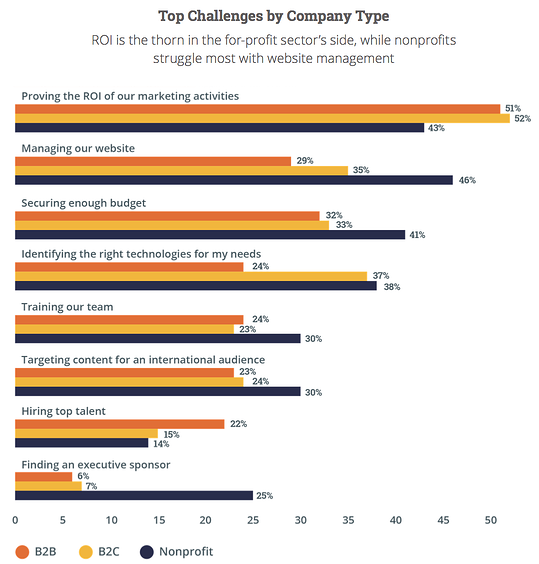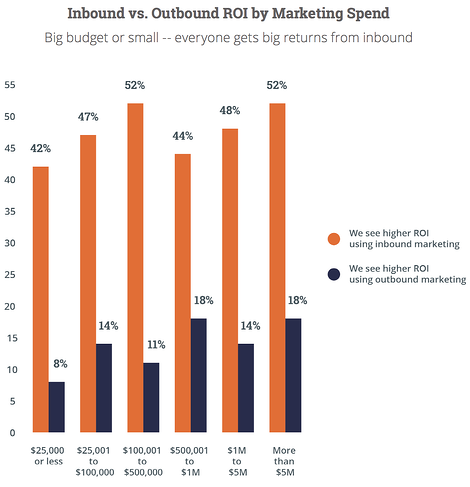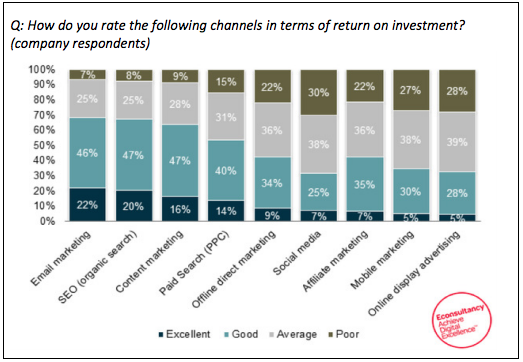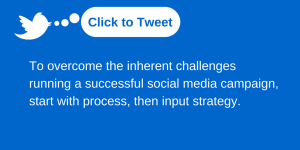We often hear from clients that the online marketing world is tough to navigate. They rely on us to provide guidance and clarity so they can make the best decisions for their business.
In the online world, the speed of technology and adoption presents unique challenges for businesses. Below are five challenges I routinely hear from clients and some suggestions on how to deal with them.
Word to the reader: if you’re a “skimmer,” be sure not to overlook the fifth topic, where I introduce Utility Marketing - one of the more recent and exciting marketing concepts.
[Update: since the original publication, and armed with some new data, we've added three more challenges to the end of the post.]
1) Social Media Management
Chances are you do not have your social media strategy figured out. Social media is still so young, that businesses are much more likely to have failed on social media than succeeded. This includes brands of all sizes - from the mom and pop shops to global brands with billions of dollars and seemingly unlimited manpower.
Common Social Media Challenges:
Questions you may already be asking yourself include:
- What kind of content should we produce?
- How can we produce remarkable content?
- How often should we sell on social?
- Who will do the work?
- How do I hold them accountable?
- Do I have the right person to lead and execute my social strategy?
Work on process:
Deming famously observed that most problems in business can be traced back to process. In my observations working with clients, I’m more likely to see a flawed process for managing social than a flawed content strategy. Granted, I don’t often see great content strategies either, but it’s even more rare to see a great process. Given the choice, you’d rather have a content problem than a process problem. Content and strategy are relatively easy to fix. Incorporating a disciplined process for execution, measurement, and accountability is much more difficult.
To overcome the inherent challenges running a successful social media campaign, start with process, then input strategy.
2) Getting Value From SEO
I’ve written repeatedly on the challenges facing SEO firms today. From the changing algorithms to the lack of keyword data, it’s become harder to get results and even harder to see results. Not a fun combination. The biggest losers were the companies that relied on these search engine rankings for the majority of their online revenue. Once the rankings disappeared, the revenue stopped.
Even if you don’t find yourself in recovery mode, trying to break through the competition without the availability of effective low-cost solutions has many questioning the value of SEO. And rightfully so! Simply put, the cost of input has increased while the expected output has decreased. That’s a dangerous trend.
Reset expectations:
Ultimately, we want to know how much revenue can be attributed back to your search engine visibility. That hasn’t changed, but how you make that connection isn’t as transparent. You have to be smarter and willing to dig deeper into your data.
What do I mean by that?
DO NOT rely heavily on rankings as a barometer of progress. The personalization of search results based on your specific location and your search history can significantly alter what one person sees compared to the person 10 miles away.
DO use the multi-attribution report to see how many assisted conversions are a result of organic site visitors.
DO NOT create pages and pages of weak content simply to attract search engine traffic. Even if you’re successful at increasing traffic volume, no one will want to stay on your site after they’ve read your content. Remember: Grade A quality or bust.
DO create a consumer-centric culture that makes people want to come back and recommend you to their friends and colleagues (more on consumer-centric approach below).

3) Multi-Device Usage
As a data-driven agency, one of our biggest challenges is how to track the visitor experience across multiple devices over the course of the consumer buying cycle. I wrote about this a couple months back, but here’s a quick refresher:
Day 1: potential customer is on their couch with their iPhone. They see your product in their Facebook news feed. They click through to your site, take a look, and then move on.
Day 6: that same potential customer is now on their iPad researching products like yours. They can’t remember your brand, but while searching for your type of product, you come up in a Google search result, along with your competitors. They have a look around and compare prices and features, but still don’t buy.
Day 15: potential customer is on their desktop computer with their credit card in hand. Having seen your website a couple times already, the consumer remembers your web address and goes to it directly. They add the item to their cart and successfully purchase.
How can you possibly trace that sale back to its origin (which should be split between Facebook and Google)? According to your analytics, Facebook and Google both sent you a visitor that didn’t convert. If that happens several dozen times, the conversion rate on these channels starts to take a major hit, leading you to question the value of those channels.
But remember, those channels played an integral part in leading up to the purchase.
There are no easy solutions, but being aware of this behavior is the first step to making smarter decisions with the data available, even if it doesn’t tell the whole story.
4) Optimizing The Mobile Experience
For years you’ve been hearing about the mobile revolution. As former Google CEO Eric Schmidt put it, “the trend has been mobile was winning. It’s now won.”
I’ve watched client’s mobile traffic go from 5% to 30% in the last couple years. With this shift in traffic comes drops in conversion rates, less time spent on site, and higher bounce rates.
A responsive website, which reformats your site content based on the users’ screen size, is a step towards an improved mobile experience. But if that’s all you do to cater to your mobile audience, you’re missing the boat. Mobile users have less patience, are seeking different answers, and can be at a different stages in the buying cycle. The mobile user is different and it’s up to you to find out how and why. Only then can you adjust your messaging and presentation to suit the mobile user.
5) Competing With The Noise
As businesses continue to build out their online presence, consumers are provided with more and more choices. The streets have become crowded and everyone wants a piece of the action. Staying on the front end of the curve and rising above the noise is harder than ever. If you are selling the same thing at the same price to the same people, how can you expect to win more market share and grow your business?
Consumer-Centric Approach
From Zappos, to Amazon, to Apple, the brands that obsess over the customer experience win. From product selection to customer service, from product quality down to packaging, each moment of touch was well thought out and brilliantly executed. These little touches add up to an overwhelmingly positive experience, keeping the customer coming back.
An emerging consumer-centric strategy is known as Utility Marketing, whereby you intersect the consumer at the point of a non-commercial need, become a part of their life, and remain with them when they’re ultimately ready to buy. Here’s an example:
As someone with wifi enabled devices throughout my house, I like to see the different connection speeds I can achieve from different rooms. This helps me test my wifi strength for devices like an Apple TV or Nest. Similarly, I’d like to know if my cellular connection speed is strong enough to tether my laptop to my iPhone during a client meeting.
To test these speeds, there’s a wonderful app called Speedtest. I open the app, hit Begin Test, and within seconds, I can measure my network speeds. Why doesn’t Verizon, my internet provider, or ATT, my cell phone provider, offer something so wonderfully simple and useful? They could offer the same functionality with added features. For example, placing a pin in my location so ATT can see where my signal is weak. Or Verizon can offer me suggestions on how to improve wifi reach if I register a low wifi signal. There are so many ways these companies can offer me a positive experience, offer me UTILITY, and increase my loyalty with their brand. Instead, they offer clunky apps for checking my account details (which I never use anyway).
If you find yourself scratching your head over some of these issues, you’re not alone. The companies that will continue to innovate, are obsessed over their customer experience, and are willing to invest in and develop process will have an edge in the years to come.
At WebStrategies, Inc, we help business overcome online marketing obstacles. Learn more about online marketing methods such as inbound marketing, Google Analytics, display advertising, and web design and development to start putting together the best plan for your business.
We want to hear from you. This is our top five list of the biggest challenges facing online marketing, but it may not be yours. What challenges do you face when it comes to online marketing? Let us know in the comments section below.
BONUS ROUND [Nov. 2015 Update]
Hubspot's State of Inbound Report provides some new data on digital marketing challenges. These challenges are less tactical than the ones originally outlined in my post above, so they are worth mentioning.

6) Proving ROI of Marketing Activities
Just over 50% of both B2Bs and B2Cs consider the ability to measure ROI the biggest challenge facing online marketing.
ROI is a challenge to measure, even in the digital world. I touched on one of the main causes in the third point above: multi-device usage. Browser cookies are a common way to connect website visits back to the marketing channel responsible for generating the visitor. Unfortunately, cookies do not move across different devices, so the same visitor coming to a website from a smartphone then from a laptop looks like two completely different people. This creates a "break" in the timeline of the visitor, and subsequently a "break" in our ability to attribute marketing investment back to revenue.
Content marketing and social media, two channels that appeal to users in the early stages of the buying funnel, are also difficult to attribute back to sales. The influence of content marketing and social media takes place days, weeks, or even MONTHS before a sale is made. And once a customer is finally ready to buy, their path is 'direct' (meaning they type the website directly into their browser, or walk right into the store). When this happens, it's not clear how the visitor found us or what influenced their decision to purchase. This results in another "break" in our ability to connect certain marketing activities back to the revenue it generates.
7) Managing Our Website
About one third of B2B and B2C companies consider managing their website a challenge.
Websites are not the static brochures they once were. Effective websites are dynamic, always evolving, and integrate into marketing automation and CRM systems. Simply put, they are MACHINES.
Managing a static brochure is easy, managing a machine is not.
Companies who rely on the internet to generate meaningful leads and sales for their business invest heavily in the ongoing operation of their website. This typically includes a combination of developers, digital marketers, content developers, hosting experts, and other tactical experts. Some of these positions are managed internally, others are outsourced.
In our years working with clients of all sizes, one trend has become abundantly clear: those who rely heavily on the web to generate leads and sales invest significantly in their website operations, and are never afraid to invest more.
8) Securing Enough Budget
About one third of B2B and B2C companies also consider securing enough budget a challenge.
This challenge links closely with the ability to measure ROI. When an acceptable ROI can be proven, most reasonable business owners will have no problem investing more.
For those trying to justify increased budgets for new tactics, presenting outside data is helpful.
The following chart also come from the State of Inbound report, and speak to the ROI of inbound tactics compared to outbound tactics.

No matter the company size, inbound marketing trumps outbound in terms of ROI. When deciding between new inbound and outbound tactics, inbound should always have the priority.
The case justifying inbound marketing is further supported by the following chart from Econsultancy. This report ranks email marketing, SEO, and content marketing as the top ROI digital marketing channels. These three channels are at the heart of an effective inbound marketing campaign, which further supports the importance of investing in inbound marketing.

///////
You may also be interested in ...
SEO & Social Media are Most Effective Tactics
Search Engine Optimization or Social Media for Small Businesses
Four Ways To Quickly Measure Website Effectiveness
Website Design – Is Beauty More than Skin-Deep?







Agree, disagree, or just have something to add?
Leave a comment below.